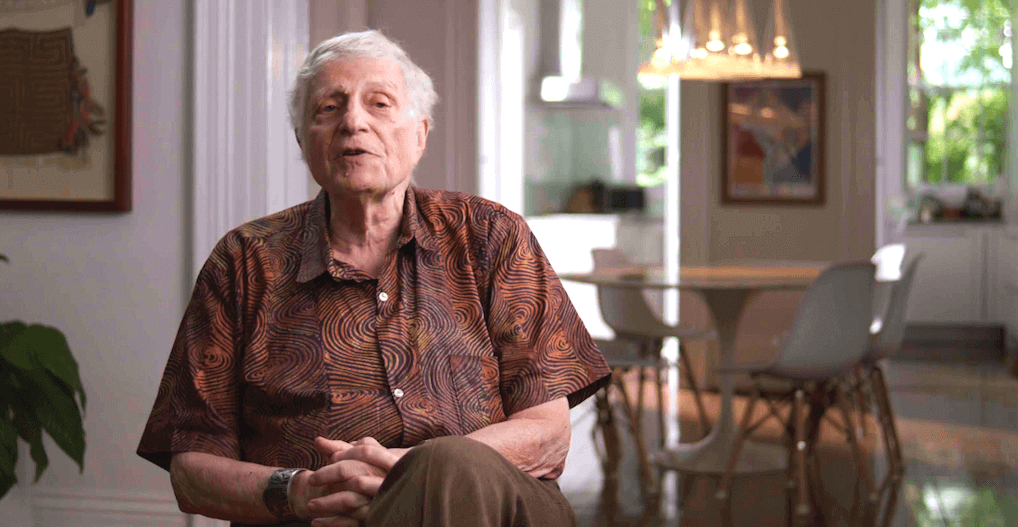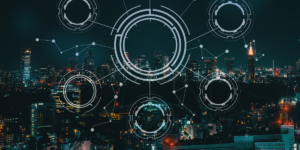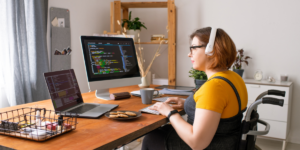
Bob Balzer was part of the original founding team of ISI in 1972 under the leadership of founder and executive director Keith Uncapher. Photo still from “Cloudwalkers: ISI and The Inventors of The Future”
What triggered the need to establish the Information Sciences Institute?
Keith Uncapher, Thomas Ellis and I were working at RAND corp. In 1972, ARPA [before it became DARPA, the Defense Advanced Research Projects Agency] wanted to give Keith twice as much funding but they couldn’t because of RAND’s ceiling; we were living under that constraint. Then the Pentagon Papers scandal appeared in RAND’s policy study – RAND’s crown jewel – and the company’s funding ceiling got cut by 20% to punish them. RAND redistributed the cuts and cut our small division’s funding by 50%: instead of doubling our budget, it went down by half! That was untenable. It forced all of us to look for an alternative. I told Keith I was leaving to join my friends who worked at Xerox Parc which was just forming [in Palo Alto, CA], and Keith realized that he was going to be left with half of the people – the ones who could not find another job. He was amenable to forming a new entity and I agreed to it as long as we were part of a university. I wanted to make sure that we had access to graduate students.
Why did you create it at the University of Southern California?
We went to UCLA first because they had a first class networking group, they were one of the first on the ARPANET [the predecessor of the internet]. They loved the idea but they are a state institution and they had to get approval from the Board of Regents, which only met every six months and included the governor. We could not wait, so we approached USC. Keith called his contacts on campus and we arranged a dinner with the Provost of the university, Zohrab Kaprielian, who was also the Dean of Engineering. Everything was decided at that dinner. We decided that ISI researchers could be tenure track faculty if they wanted to pursue that type of career. Or they could be research professors so they could supervise graduate students, but they did not have to teach any courses as the funding came from their research.
You chose to establish ISI in Marina Del Rey, why not pick a building on campus?
When we formed the institute, USC wanted us to be on campus and I refused because space on any college campus is a precious commodity, especially when you are competing against the football team – so we decided we would be off campus. We certainly counted the proximity to the LAX airport as a plus of the location as well. I live in Santa Fe now and I commuted for 19 years – I started in 1991 – flying in every week on Monday mornings. Because of the time change I was in the office by 8 o’clock, ahead of everybody else.
What was so attractive about this particular building?
Once we decided that we would be off campus, we mentally drew a triangle between where Keith Uncapher, Tom Ellis and I lived, and the ISI building was almost exactly in the center. Construction on the building was just finishing, and because we were their first tenants, we got to pick the floor we wanted. We picked the top one because we needed air conditioning for the computers that were very large at the time. We started with half a floor. Half of it was housing the computers, the other half the ISI staff. Tom Ellis looked at other buildings just so we could justify picking the current one, but neither Keith nor I ever went to the other buildings. We also knew we wanted to go to Marina Del Rey for recruiting reasons: we have the best view of any research institute on the West Coast.
The building was brand new, how did you design the office space?
When we designed the institute and its offices we decided that we would have a round conference table so it would have no head, trying to make it nonhierarchical. We had a beautiful big table and we asked to change the design of the conference room to be wider to fit the table. That table and conference room lasted until 1988.
How were your first months at ISI?
Keith Uncapher, Tom Ellis and I were the first employees for a month or so because it took a while for ARPA to get our contracts in place. I made up a new business card and my title was “The Staff,” because Keith and Tom were both management. I don’t have any of those cards anymore, but I think it’s a pretty unique title. Once the contract was finalized we brought about ten people from RAND, then we started recruiting from elsewhere.
You hired Danny Cohen, do you remember conducting his job interview?
I was a chief recruiter at ISI for a long time. I formally recruited Danny. It was a special case because DARPA informally arranged that he would come to ISI after he left Harvard. The interview occurred in my office which, at that time, was the corner office on the 11th floor. Danny was an avid pilot, and you could see LAX from my desk. Danny said that one requirement for him to come to ISI was to get my office. So I got kicked out of my office. But the timing was good because we were expanding down to the 10th floor, so I moved down there, and Danny was above me on the South West corner. It was in the process of being built, so I was able to get the office expanded a little bit. My whole division ended up having to move down to that floor to follow me.
Danny Cohen went on to be a key player in ISI’s early days. What was so special about him?
With DARPA, one of the early measures of success for the principal investigators was the success rate of the proposals they submitted. If they submitted 15 proposals over a number of years and ten were accepted, they had a 66% success rate. Danny Cohen was the only person who had a success rate above 100%, because DARPA would make him the head of a project before any proposal was sent. That’s how high the regard of Danny was: DARPA would start a program and say Danny had to be the head of it – and the proposal would come later. With Danny, we installed, at Fort Smith in Hawaii, the first email system that the military – and probably the government – ever had.
Did you have fun working at ISI?
Danny and I played a number of practical jokes on one another. We created a very early email system and we would put a lot of features in it to test before moving them to another network. I remember a time when we had just put in a vacation message feature, in 1979. I was going on vacation very shortly after that was implemented, so I put in a special message to tell people that I was on vacation, and that they needed to wait for me to get back. Danny forged a message to me, from me, so this automated reply would be in an endless loop. But I had actually created this vacation message code and I put a line in it saying to only send it once to any particular recipient because it would be silly to keep telling them that I was on vacation. So I did get one message from myself to myself saying that I was on vacation, but then it stopped. Danny was very disappointed that his prank did not work.
Are you saying that you invented this function?
I don’t believe the out of the office message was created before that, we built it because we had never heard that it existed anywhere else.
Do you have any other fond memories from that time?
The mounting of the satellite dish had to be placed on our roof in the 1990s. When that was happening we had to vacate the building, like a fire drill. Everybody was down on the street watching it go up. I cannot remember if they brought it with a crane, or a helicopter. It was a special moment for all the ISI employees.
Published on December 15th, 2022
Last updated on December 16th, 2022













